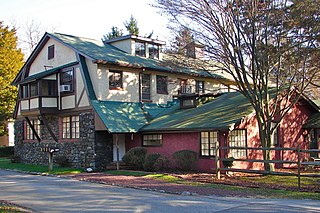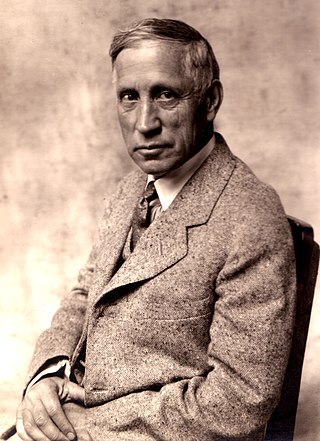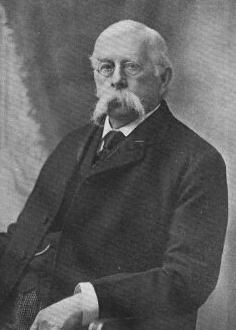
Arden is a village in New Castle County, Delaware, United States, founded in 1900 as a radical Georgist single-tax community by sculptor Frank Stephens and architect William Lightfoot Price. The village occupies approximately 160 acres, with half kept as open land. According to the 2010 census, the population of the village is 439. In 1973, the entire village was listed on the National Register of Historic Places.

Harvard is a town in Worcester County, Massachusetts, United States. The town is located 25 miles west-northwest of Boston, in eastern Massachusetts. It is mostly bounded by I-495 to the east and Route 2 to the north. A farming community settled in 1658 and incorporated in 1732, it has been home to several non-traditional communities, such as Harvard Shaker Village and the utopian transcendentalist center Fruitlands. It is also home to St. Benedict Abbey, a traditional Catholic monastery, and for over seventy years was home to Harvard University's Oak Ridge Observatory, at one time the most extensively equipped observatory in the Eastern United States. It is now a rural and residential town noted for its public schools. The population was 6,851 at the 2020 census.

The Warren Anatomical Museum, housed within Harvard Medical School's Countway Library of Medicine, was founded in 1847 by Harvard professor John Collins Warren, whose personal collection of 160 unusual and instructive anatomical and pathological specimens now forms the nucleus of the museum's 15,000-item collection. The Warren also has objects significant to medical history, such as the inhaler used during the first public demonstration of ether-assisted surgery in 1846, and the skull of Phineas Gage, who survived a large iron bar being driven through his brain. The museum's first curator was J.B.S. Jackson.

Beacon Hill is a historic neighborhood in Boston, Massachusetts, United States, and the hill upon which the Massachusetts State House resides. The term "Beacon Hill" is used locally as a metonym to refer to the state government or the legislature itself, much like Washington, D.C.'s Capitol Hill does at the federal level.

Frederick Law Olmsted National Historic Site is a United States National Historic Site located in Brookline, Massachusetts, a suburb of Boston. Frederick Law Olmsted (1822–1903) is recognized as the founder of American landscape architecture and the nation's foremost parkmaker of the 19th century. In 1883, Olmsted moved his home to suburban Boston and established "Fairsted", the world's first full-scale professional office for the practice of landscape design. Over the course of the next century, his sons and successors expanded and perpetuated Olmsted's design ideals, philosophy, and influence.

Frederick Fiske Warren was a successful paper manufacturer, fine arts doyen, United States tennis champion of 1893, and major supporter of Henry George's single tax system which he helped develop in Harvard, Massachusetts, United States, in the 1930s. Fiske Warren established Georgist single-tax colonies and a social experiment in Andorra to disprove Malthus's population theory.

Gretchen Osgood Warren was an American actress, singer, and poet. She was the wife of Fiske Warren. The daughter of Dr. Hamilton Osgood and Margaret Cushing Osgood of Beacon Hill, Boston, Massachusetts, her younger sister was Mary Alden Childers, the wife of writer and Irish nationalist Erskine Childers. Her nephew Erskine Hamilton Childers served as the fourth President of Ireland from 1973 to 1974.

The Dr. Henry Jacob Bigelow House is a historic house at 72-80 Ober Road in the Oak Hill village of Newton, Massachusetts. Built in 1887, it is one of the last private residences designed by noted American architect Henry Hobson Richardson. It was converted into condominiums in the 1980s by the PBS program This Old House. It was listed on the National Register of Historic Places in 1976.

Ticknor and Fields was an American publishing company based in Boston, Massachusetts. Founded as a bookstore in 1832, the business published many 19th-century American authors, including Ralph Waldo Emerson, Nathaniel Hawthorne, Henry James, Henry Wadsworth Longfellow, Harriet Beecher Stowe, Henry David Thoreau, and Mark Twain. It also became an early publisher of The Atlantic Monthly and North American Review.

The Unitarian Universalist Church of Medford and The Osgood House are a historic Unitarian Universalist church building and parsonage house at 141 and 147 High Street in Medford, Massachusetts.

Harvard Shaker Village Historic District is a historic former Shaker community located roughly on Shaker Road, South Shaker Road, and Maple Lane in Harvard, Massachusetts. It was the second oldest Shaker settlement in Massachusetts and the third oldest in the United States.
Warren House may refer to:

The Lewis Cabot Estate was a historic estate at Warren and Heath Streets in Brookline, Massachusetts. The estate, developed in 1894, was one of few surviving turn-of-the-century properties of the Boston Brahmin Cabot family, and a prominent local example of Jacobethan architecture with landscaping by Frederick Law Olmsted. The remnant portion of the estate was listed on the National Register of Historic Places in 1985; the main house has since been demolished.

Clara Endicott Sears (1863–1960) was a New England author, preservationist, and philanthropist.

Daniel Pinckney Parker was an American merchant, shipbuilder, and businessman in 19th-century Boston, Massachusetts.

Mrs. Fiske Warren and Her Daughter Rachel is a 1903 oil on canvas portrait painting by American portrait painter John Singer Sargent of Gretchen Osgood Warren, an American actress, singer, and poet, and her daughter Rachel Warren. The painting measures at 152.4 × 102.55 cm (60.0 × 40.4 in) and is exhibited at the Museum of Fine Arts in Boston, Massachusetts. The museum acquired it on 13 May 1964.
The Samuel Dexter House is a historic house at 699 High Street, Dedham, Massachusetts. It was built, beginning in July 1761, by Samuel Dexter, a member of the Massachusetts Provincial Congress.

George Warren Hammond was an American businessman. Camp Hammond, in Yarmouth, Maine, is named for him. He was also one of its architects. Built in 1889, it was placed on the National Register of Historic Places in 1979.



















